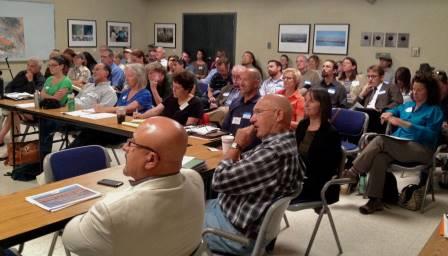 |
|
June 2015 Newsletter More events, including volunteer restoration opportunities, are listed on the Events and Meetings section of the project web site. Meetings Joint Stakeholder Forum & Working Groups Meeting Tuesday, August 4 Walking Tour: 1:30 - 2:30 p.m.Ponds R5/S5, Menlo Park (tour details to come!) Meeting: 3:00-5:00 p.m. Mountain View Community Center, 201 S. Rengstorff Ave., Mountain View Map Website All stakeholders and members of the public are invited to our periodic update meeting, to learn about and share your views on the restoration. This year, the day's events will begin with a 1:30 p.m. walking tour at Menlo Park ponds R5 & S5, where we are looking at adding trails and stormwater retention capacity. At 3 p.m. we will convene in Mountain View - the meeting will include discussion of our work to find fill for building high marsh habitat, an update on current Project planning, science and funding. We will send out further information about the meeting as the agenda is developed, or check back on the project website Events and Meetings page. Public Hearing, Draft Environmental Impact Analysis for Phase 2 Alviso & Ravenswood Construction Tuesday, August 4 6:00-8:00 p.m.Mountain View Community Center, 201 S. Rengstorff Ave., Mountain View Map Link Website Link This is your opportunity to ask questions and provide your thoughts in person on the draft environmental impact document for our next round of restoration and public access construction at the Alviso ponds near San Jose and Mountain View, and at the Ravenswood ponds near Menlo Park. The meeting will be held an hour after our Stakeholder Forum & Working Groups meeting, to allow time for a meal and movement break. The draft document will be released in mid-July - at that time we will announce how to access it and how to submit your comments during the 60-day comment period. We will email further information as the agenda is developed, or check back on the project website Events and Meetings page. 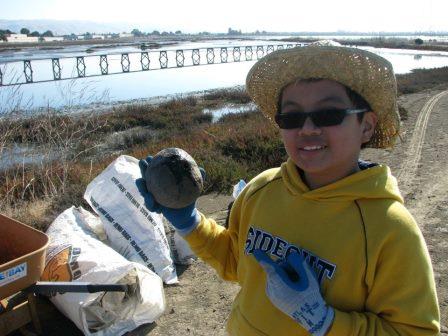 Tours and Volunteer Opportunities July 2015 Going Green, the Restoration of the South Bay Salt PondsSaturday, July 11 10:00 - 11:00 a.m. Refuge Environmental Education Center, Alviso Join an interpretive walk to photograph the wildlife and wetlands in the South Bay Salt Pond Restoration Project. Knowing the area will both increase your appreciation for the Baylands and the ability to see them in whole new way. Discover plants and animals in its habitat and the best time to see them. Cameras welcome. Led by Joseph Garcia. Call 510-792-0222 ext. 141 or register at .http://sbspp.eventbrite.com. Embrace Your Geekness Day at Ravenswood Saturday, July 11 9:00 a.m. - 12:00 p.m. Ravenswood Ponds, Menlo Park Celebrate your love of learning and enjoy Embrace your Geekness Day with Save The Bay! Learn about native and non-native plant species as you get some fresh air and help pull invasive weeds to restore the wetlands at Ravenswood Pond. If habitat restoration alone isn't enough to entice you to join, you can also exercise your inner bird nerd as this is a perfect birding spot. See you there! Click here to register. Habitat under Construction - Alviso Salt Ponds Sunday July 19 10:00 a.m. - 11:30 a.m. Refuge Environmental Education Center, Alviso Come take a van ride to see how the salt ponds are transforming and creating new habitat. You will see varying stages of habitat under construction and how the wildlife is returning. A short orientation and discussion will be held in the auditorium prior to the pond tour. Bring a camera and binoculars for better viewing. Space is limited. Register at http://huceec.eventbrite.com or call 510-792-0222 ext. 362. Led by George Trevino. August 2015 Fossils and FlumesSaturday, August 1 11:00 a.m. - 12:30 p.m. Environmental Education Center, Alviso Fossils and flumes help teach children about the South Bay Salt Pond Restoration Project. Park Ranger Jose Garcia brings fossils from Triassic wetlands he collected in eastern Montana to show the similarities to wetlands today. We'll learn what their function is in nature. Interactive flumes allow for a hands-on experience of how wetlands protect the surrounding area from flooding. Register at http://fofleec.eventbrite.com or call 510-792-0222 ext. 141. Docent Training Saturday, August 1 11:00 a.m. - 12:00 p.m. Refuge Environmental Education Center, Alviso Want to become a volunteer or update your training? Come to a Salt Pond Restoration Docent Volunteer Training class where Park Ranger Joseph Garcia will teach you the volunteer process and what new changes are taking place within the refuge. Register at Eventbrite or call 510-792-0222 ext. 141. Celebrate Smokey's birthday Saturday, August 8 9:00 a.m. - 12:00 p.m. Eden Landing (Hayward/Union City) Smokey the Bear always says "only YOU can prevent forest fires". Here at Save The Bay, only volunteers like YOU can help restore our native marsh habitats! Come to Eden Landing to celebrate Smokey the Bear's birthday and show your community support by getting your hands dirty pulling weeds and watering recently planted native seedlings. In participating, you will be part of the South Bay Salt Pond Restoration Project, the second largest wetland restoration effort in the nation! Click here to register.  
Facebook and Twitter Users Can Follow the Salt Pond Restoration! Want to receive regular updates, interesting trivia and the latest pictures and videos about the South Bay Salt Pond Restoration? Join us on Facebook or follow us on Twitter. Photo Credits:Crystal Shore at USGS, Judy Irving, USFWS View a complete list of our partners, major donors and participants. 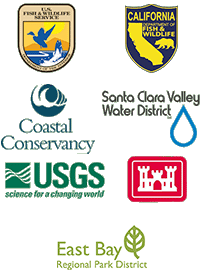
|
Contents
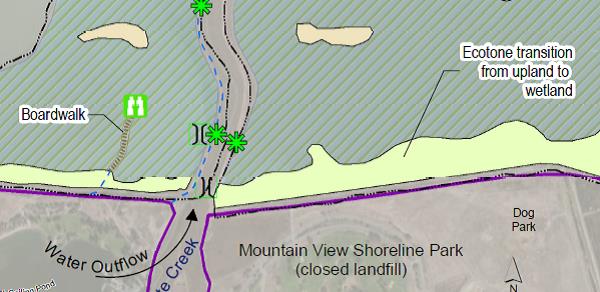 Draft Phase 2 EIS/R Out Mid-July, August 4 Meetings on Tap
Draft Phase 2 EIS/R Out Mid-July, August 4 Meetings on Tap
We will soon publish the draft environmental impact statement/report (EIS/R) for our next set of construction work at the Alviso and Ravenswood Ponds. The public is invited to review and give us your comments on the draft document, and to attend a set of meetings and a tour slated for Tuesday, August 4. The EIS/R provides specifics on our plan alternatives and analyzes the potential environmental impacts of the proposed changes. The range of Phase 2 work we are considering includes breaching ponds to create salt marsh; building nesting islands; adding fill so marsh animals can escape to high ground; installing trails, footbridges, viewing platforms and interpretive signs; and, at one set of ponds, allowing for flood storage for nearby runoff. We will send an announcement when the draft document is available, detailing how you can review it and provide input, and on the meetings as details are developed. If you would like to sign up for our mailing list, or manage your updates, see Newsletter Sign up. Information will also be posted on the Project website and available through http://www.southbayrestoration.org/events/. August 4 events
We will hold the public hearing on the draft environmental impact statement/report on Tuesday, August 4, from 6:00 to 8:00 p.m. in Mountain View. The meeting is an opportunity for members of the public to learn more, share their comments in a large group setting, and talk one-on-one with Project managers and consultants. We will also receive input via email, the Project website, and regular mail. Earlier in the afternoon of August 4, at 1:30 p.m., we will hold a walking tour of ponds R5 and S5 in Menlo Park, one site discussed in the Phase 2 EIS/R, where we are considering new trails, pond management enhancements and stormwater retention. The tour will be followed by the 3 p.m. joint meeting of the Project Stakeholder Forum and Working Groups. This meeting is an opportunity to learn about and discuss broader aspects of the restoration. This meeting will be held at the Mountain View Community Center. See the sidebar to the left for details and links for more information. If you need any accommodations to review documents or attend the events, please contact Ariel Ambruster at (510) 528-5006 or [email protected]. Note: This environmental report does not cover the same content as a draft environmental report released in December 2014 for our sister project, the South San Francisco Bay Shoreline Study. It is coincidental that the two draft environmental analyses were completed within a similar timeframe. The Shoreline Study project includes additional restoration beyond our Phase 2 plans, and includes a major focus on flood risk management, including the development of levees to protect the Alviso area from sea level rise. On the Ground: Track Our Progress Major Eden Landing construction wraps up, 2016 opening planned .jpg) About $3 million worth of heavy construction is complete at the Eden Landing Ecological Reserve near Hayward. Workers have finished a kayak launch, a boardwalk through historic saltworks, and a pumping system to calibrate water and salt levels at a set of shallow ponds for foraging shorebirds. After a quiet summer to allow for nesting and chick fledging, construction crews will be back in the fall at the State Department of Fish and Wildlife-owned reserve to lay on the final touches: gravel, fences and signs. This last bout of construction work was funded by the state Wildlife Conservation Board and supervised for the Department of Fish & Wildlife by Ducks Unlimited. We expect to welcome the public on to these new trails and off the boating launch in early 2016. Florence LaRiviere Named a National Champion! 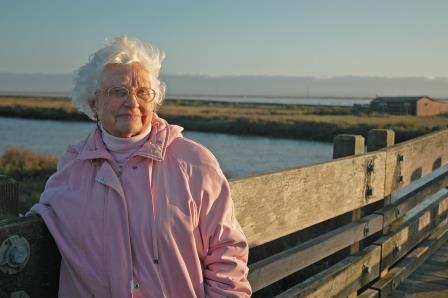 Florence LaRiviere, cofounder of the Citizens' Committee to Complete the Refuge, was honored nationally by the US Fish and Wildlife Service this spring, named one of 69 U.S. 2014 Endangered Species Recovery Champions. Florence has worked to protect San Francisco Bay tidal marshes and marsh species since the 1960s. She and other concerned community members' advocacy was instrumental in the birth of the Don Edwards San Francisco Bay National Wildlife Refuge. The work of the Citizens' Committee succeeded in more than doubling the size of the Refuge. The Service, in commending Florence, said, "Mrs. LaRiviere's pioneering efforts to establish this first ever ‘friends' group in support of a national wildlife refuge is a model for what a friends group can accomplish." For more information, see http://www.fws.gov/endangered/what-we-do/recovery-champions/. Science Updates Fake birds successfully attract the real deal! 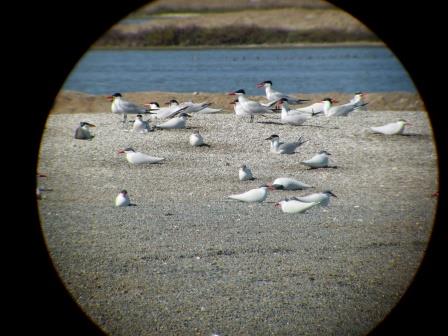 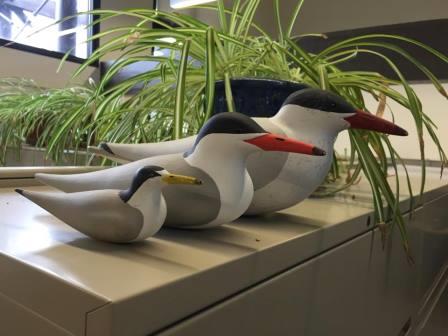 Recorded bird calls and 100 carefully placed decoys have done the trick at the Refuge, attracting about 150 Caspian terns to nesting islands in Alviso and Ravenswood ponds, where they have formed colonies and laid eggs. The Alviso birds, at Pond A16, are visible from the Mallard Slough trail off the Refuge's Environment Education Center, and the Ravenswood birds at Pond SF2 can be seen from the bike trail on the south side of Highway 84. The project was funded by the US Army Corps of Engineers and launched this spring. First endangered rail spotted at restored wetlands 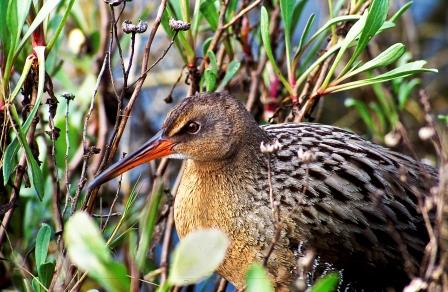 We were thrilled this fall to learn that the first endangered salt marsh animal was seen lurking in one of our restored ponds. The Ridgway's rail, a creature known until this year as the California clapper rail, was sighted at Island Pond A21 in the Coyote Creek delta. We breached the pond nine years ago, in 2006, so Bay waters could bring in mud. Once there is enough sediment, pickleweed and other salt marsh vegetation begins to grow. Rails are very secretive birds, about the size of a chicken, so they need fairly dense and tall plants to hide in. The sighting indicates that plants on the island may be large enough to give the birds secure cover. Shoreline Study Final Feasibility Study and Environmental Document Underway After gathering numerous comments from the public this winter, the U.S. Army Corps of Engineers and its local partners are working to finalize the feasibility study and environmental document for the South San Francisco Bay Shoreline Study. The Corps and partners, the Santa Clara Valley Water District and the State Coastal Conservancy, have worked many years to develop the plan, which, would build new 15-foot-high levees on the San José bayfront, restore about 3,000 acres of wetlands, and provide public trails. To look at the draft feasibility study and environmental document, see www.valleywater.org/PublicReviewDocuments.aspx. To review the presentation, handouts and summary from the January public meeting on the document, see http://www.southbayshoreline.org/events.html. Once the feasibility study and environmental document are finalized, the plan will require internal Army Corps approval, and would then need Congressional authorization and funding. Salt Pond Restoration in the News A compendium of recent media coverage The Restoration has had a high profile lately - the Project was the subject of a PBS NewsHour segment in the fall, and this spring, a photographer from National Geographic magazine has visited as part of a planned 2016 story on how the Bay is handling sea level rise adaptation. To see recent media coverage:
Friends of Don Edwards Donate on Behalf of His 100th Birthday The Project received a number of individual donations, amounting to $2,875, from friends and supporters of Rep. Don Edwards, in honor of his 100th birthday this past January. The former Congressman from San Jose was instrumental in creating the nation's first urban wildlife refuge, which now bears his name - the Don Edwards San Francisco Bay National Wildlife Refuge. The contributions are very helpful as we continue to look for funds to pay for the scientists who are tracking fish and birds, measuring contaminant levels, and doing other key research to make sure the restoration maximizes South Bay environmental health. Cargill Donates 50 Acres to the Refuge Cargill recently donated 50 acres of Sunnyvale channel and paved levee to the Don Edwards San Francisco Bay National Wildlife Refuge. The channel is 1.5 miles long and 100 feet wide, and borders the Sunnyvale Water Pollution Control Plant and Refuge ponds A3W and A4. It is used by a variety of birds and waterbirds. The donation went forward after NASA removed two abandoned fuel pipelines from the property. Cargill's donation and sale of former industrial salt ponds to federal and state agencies launched the Restoration Project more than a decade ago. Faces of the Restoration: Cay Goude 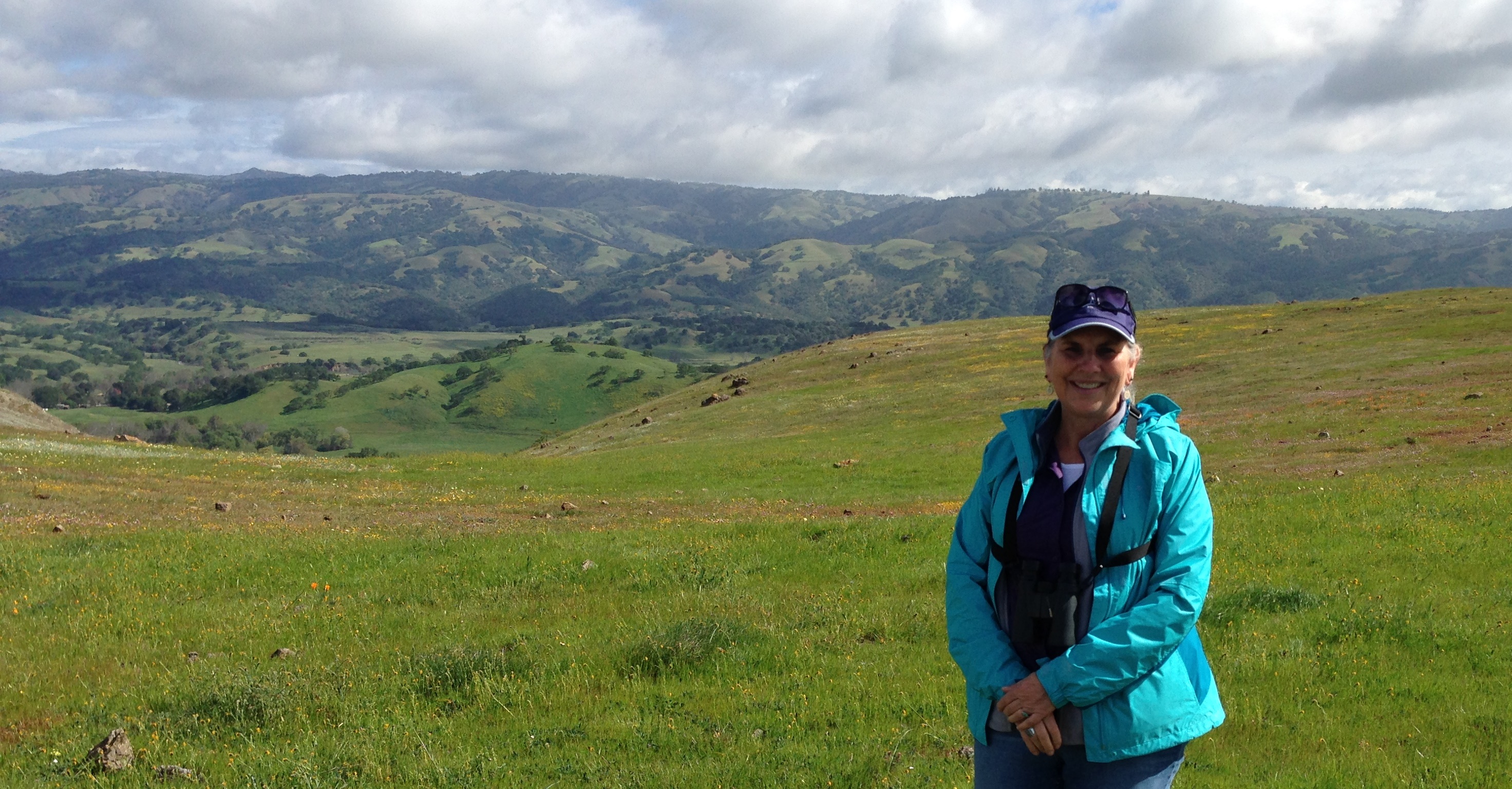 Cay Goude (pronounced like 'goodie') has been well-known to many in the Bay Area environmental community as a champion of endangered species, through her work over the last 30 years at the U.S. Fish and Wildlife Service's Ecological Services office in Sacramento. The office shares responsibility for administering the Endangered Species Act. Cay recently retired, and we took advantage of the milestone to ask her to talk about her thoughts and her work, most recently as Assistant Field Supervisor, where she was responsible for all federal habitat conservation planning and species recovery planning for the Bay Area, the Sierra foothills and the Coast Range. We caught up with her at home as she babysat her three granddaughters.
|
| Subscribe to the newsletter. | |
